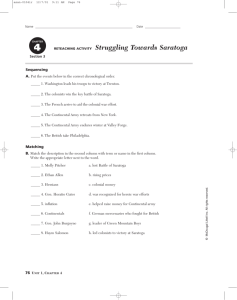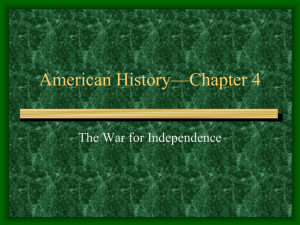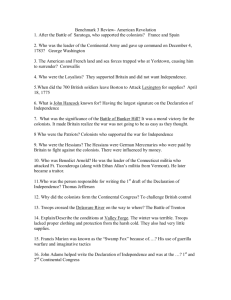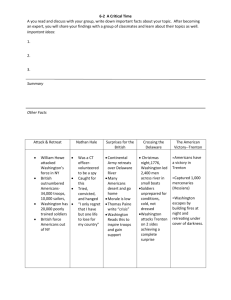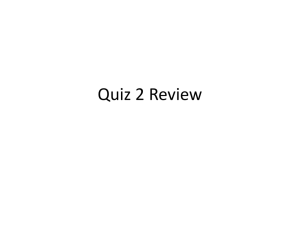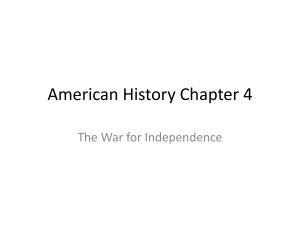The American Revolution
advertisement
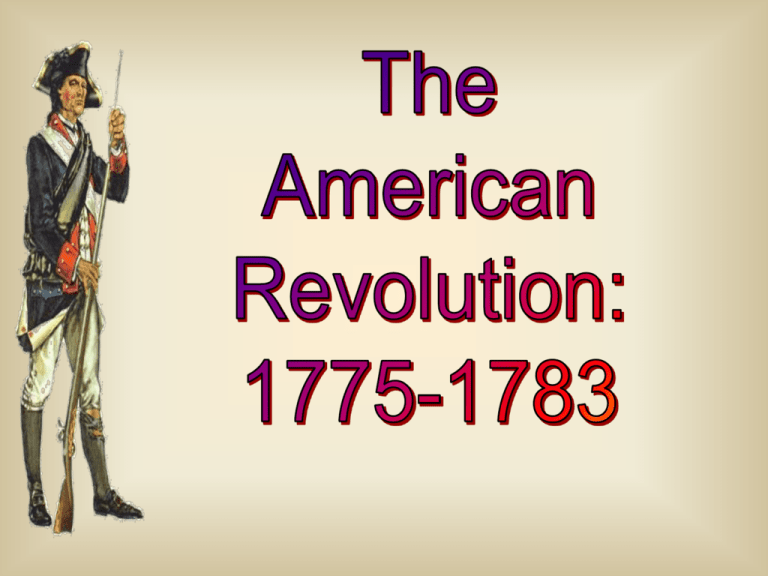
Performance Objectives • PO 2. Describe the significance of key events of the Revolutionary War: • major battles (e.g., Lexington, Saratoga, Trenton) • aid from France • surrender at Yorktown More Performance Objectives • PO 3. Describe the impact of the following key individuals on the Revolutionary War: – Benjamin Franklin – Thomas Jefferson – George Washington – Patrick Henry – Thomas Paine • King George III Causes of the War • British defeat French in French/Indian War – Defeat of Indians removes colonists’ perceived need for British protection – War costly for Brits and need add’l income • Stamp, Navigation, and Revenue Act force colonists to pay for protection • 1770 Boston Massacre – 5 dead after protesting taxation w/o representation Causes of the War (cont.) • Quartering Act – Colonists forced to house British troops – 3rd Amendment of the Constitution • Real Causes – Colonists had intellectual differences with British government – Spirit of independence brought about by frontier life – Belief in democracy over oligarchy On the Eve of the Revolution ? Britain Americans Advantages ? ? Disadvantages ? ? Military Strategies The Americans Attrition [the British had a long supply line]. Guerilla tactics [fight an insurgent war you don’t have to win a battle, just wear the British down] Make an alliance with one of Britain’s enemies. Rely on love of home to keep men fighting The British Break the colonies in half by getting between the North & the South. Blockade the ports to prevent the flow of goods and supplies from an ally. “Divide and Conquer” use the Loyalists. Loyalist Strongholds Washington’s Headaches Only 1/3 of the colonists were in favor of a war for independence [the other third were Loyalists, and the final third were neutral]. State/colony loyalties. Congress couldn’t tax to raise money for the Continental Army. Poor training [until the arrival of Baron von Steuben]. Phase I: The Northern Campaign [1775-1776] Fort Ticonderoga • Ethan Allen, a blacksmith, leads the Green Mountain boys of Vermont against the fort which had many cannon. • There was one guard and the officers were sleeping. • The commander had to turn over 100 cannon and gunpowder. Second Continental Congress • 13 colonies send delegates to Philadelphia. • Many do not want a war. • The Olive Branch Petition is sent to King George asking him to repeal the Intolerable Acts. • The Continental Army is created with George Washington as Commanderin-Chief. Bunker (Breed’s) Hill Jun 1775 • New “Continental Army” takes position on Breed’s Hill • They are told, “Don’t shoot until you see the whites of their eyes!” because they have only a small amount of gunpowder • British conduct frontal assault – Poor judgement – flanks/rear exposed – 40% casualties for Brits (1,100 dead) • Colonials repel two assaults but run out of ammunition. Bunker Hill (June, 1775) The British suffered over 40% casualties. Results of Bunker Hill • Colonists convinced standing army was unnecessary • Showed colonial determination • Gen Howe forever failed to press victories • New colonial tactics: – Simple defensive – Hold at the Hudson Brits Leave Boston • By January 1776, the Continental Army surrounded Boston. • The cannon captured at Ticonderoga were placed on a hill overlooking Boston and its harbor. • Seeing that they were trapped, General Howe ordered his troops to go to Halifax, Canada. Common Sense • Many colonists remained loyal to Britain, even while patriots were fighting for freedom. • Thomas Paine wrote a pamphlet called Common Sense. • This pamphlet asked anyone to “show single advantage this continent can reap by being connected with Britain. • Hundreds of thousands of copies were sold. • Many loyalists changed their thinking because of Paine’s arguments. Declaring Independence • Delegates to the Continental Congress came to believe that declaring independence was necessary. • Richard Henry Lee of Virginia offers a resolution that “these United Colonies are, and of right ought to be, free and independent States.” • From that moment, delegates were considered traitors to their country. A traitor is one who betrays his or her own country. • A committee is formed to write the declaration. • John Adams, Benjamin Franklin, Robert Livingston, Roger Sherman and Thomas Jefferson undertake this task. • Jefferson is asked to write the document explaining to the world why the colonies were taking such a drastic step. • On July 4th, 1776, the Congress voted that the 13 colonies were “free and independent States. • Fireworks were invented later The Declaration • The first part explains the basic rights on which the nation is founded. Finish this phrase, “We hold these truths to be self-evident………………… • The second part list the wrongs committed by Britain • The last section declares that the colonies had become “the United States of America.” Phase II: NY & PA [1777-1778] New York • Gen. Howe (Brit) heads to New York City. • Washington takes the Continental Army to defend the city. • Howe has 34,000 troops, 10,000 sailors, 30 warships and 400 smaller boats. • Washington has 20,000 men and no navy. • Losing the battles for New York, the Continentals retreat to New Jersey. • Nathan Hale, a young Connecticut spy is captured behind British lines. • “I only regret that I have but one life to lose for my country” were his last words… New York City in Flames (1776) Trenton and the Crossing • Discouraged with losing, the Continentals are cold, hungry, deserting and many are due for re-enlistment • A victory is badly needed. • Washington plans a surprise attack on Hessian troops (German mercenaries) in Trenton , New Jersey. • He gets his troops across the frozen Delaware River in the dead of night on Christmas. • On Dec. 26, the Continental Army takes over 1400 Hessians prisoner without losing a single soldier! Washington Crossing the Delaware Painted by Emanuel Leutze, 1851 Princeton • After the Battle of Trenton, the British send General Charles Cornwallis to retake the city. • Outside of Princeton, he sees the lights of Washington’s campfires. • “At last we have run down the old fox and we will bag him in the morning.” • Washington had fooled Cornwallis by leaving the fires burning as he marched his troops behind British lines, winning another surprise victory. • The army has new hope and confidence. British Plan in Pennsylvania • General Burgoyne (British) convinces King George that if New England is cut off from the other colonies the war will end. • 3 British armies march on Albany, N.Y. from different directions. • General Howe must take Philadelphia before going to Albany. He takes too much time • General St. Leger (British) moves slowly due to baggage carts. • Burgoyne is surrounded in the village of Saratoga. • The 3 armies never reached Albany… The Battle of Saratoga • The battle of Saratoga is an interesting one. • This was when 6,000 British troops were in upstate New York, traveling southbound. • The American troops cut or burned down all of the bridges in their path. • This made the British an easy target for the American soldiers. Follies at Saratoga • Burgoyne sets off with an overbundance of supplies/equipment – Movement extremely slow (1 mile/day) – Guerillas could easily stay ahead and slow further • Delays allow colonials to reinforce and win. Significance of Saratoga • Turning point of Revolution • French enter war, aligning with colonists • British now move their focus to the South • Spain and Holland soon join war – British forced to protect its own borders from aggressors – British concerned about about long ocean supply lines Saratoga: “Turning Point” of the War… A modern-day re-enactment Southern Campaign Late 1778 • More Loyalists live in the South • Southern resources more valuable • British win small victories but unable to pacify countryside • Nat Greene vs. Cornwallis – Greene sacrificed mass for manuever – Smaller forces more easily could live off land – Provided rally points for local militia – Tempted Cornwallis to split his forces Phase III: The Southern Strategy [1780-1781] The Swamp Fox • In the southern battles, Americans began to employ hit and run, or guerrilla, tactics. • Francis Marion of South Carolina led a small band of men who slept by day and traveled by night. • He was known as the Swamp Fox because he appeared suddenly out of the swamps, attacked the British, and then retreated back to the swamps. • His actions kept the British off balance John Paul Jones • Although the American navy remained small, Americans attacked and captured British ships at sea. • John Paul Jones, in command of the Bonhomme Richard, finds a British warship, the Serapis, guarding 39 merchant ships in the North Sea off the coast of Britain. • He attacks, even though the Serapis is larger. • When told to surrender, Jones states, “I have not yet begun to fight!” • His men board the warship and defeat the men in hand-to-hand fighting. Tale of a Traitor • By 1780, one of Washington’s most talented and successful generals, Benedict Arnold, was in command of the American fort at West Point. • He was angry at what he felt was a lack of credit given to him for his victories. • He offered to turn the fort over to the British! • His plot almost succeeded but soldiers caught the messenger taking the offer to the British. • Arnold escaped and joined the British and, to this day, a synonym for traitor is a “Benedict Arnold.” Yorktown • Cornwallis consolidates forces • French defeat British ships at Battle of Capes • Americans to front; French to rear • British surrender 17 Oct 1781 The Battle of Yorktown (1781) Count de Rochambeau Admiral De Grasse Impact of French • Anxious to regain international position • French repeatedly help American cause: – Loans of money – Use of French ports by American privateers – Protected American vessels near French waters • Made English uneasy at home • French Navy critical at Yorktown Cornwallis’ Surrender at Yorktown: “The World Turned Upside Down!” Painted by John Trumbull, 1797 North America After the Treaty of Paris, 1783
